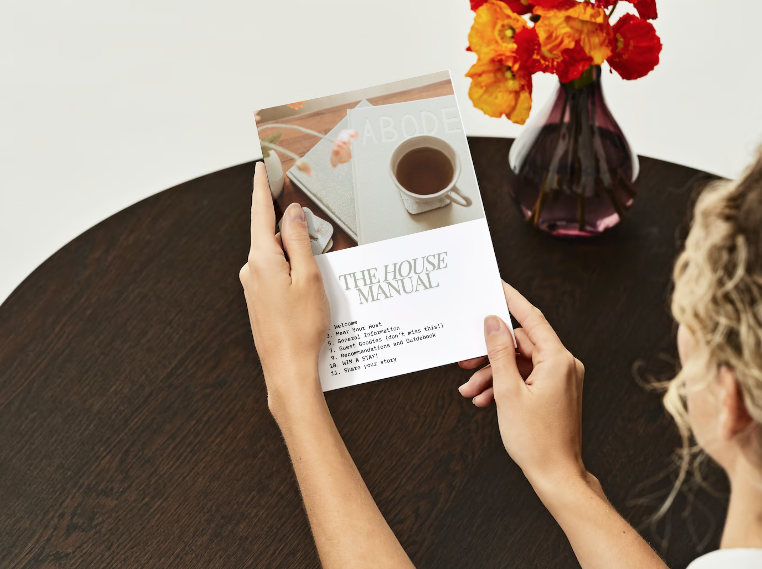How to Create a House Manual To Optimise Hands-Off Hosting
One of the most powerful tools in your Airbnb hosting toolkit is something many hosts overlook: the guest welcome book. This simple resource can set the tone for your guests’ entire stay, answer common questions, and even prevent potential issues. But to really make an impact, your welcome book needs to go beyond the basics. Here’s how to create a guest welcome book that not only informs but delights.
1. Craft a Warm Welcome
The introduction section of your welcome book should make your guests feel genuinely welcomed. Start with a friendly note introducing yourself (or your property management team) and expressing your excitement about their stay.
Personalize the Message: A personalized note can make a big difference. Mention something specific about the guest’s trip or the reason for their stay if you know it.
Include a Photo: Adding a photo of yourself or your family can make the introduction feel more personal and less formal.
2. Detail House Rules and Practical Information
While you want to keep the tone friendly, it’s crucial to clearly communicate your house rules and practical information. This helps set expectations and avoids misunderstandings.
List Rules Clearly: Outline key house rules such as no smoking, no pets, or quiet hours. Use bullet points for easy readability.
Include Practical Information: Provide instructions for using appliances, Wi-Fi passwords, and details on how to handle trash and recycling.
Emergency Contacts: Include important contacts such as emergency services, local hospital, and your own contact information for any issues that arise.
3. Share Local Recommendations
One of the best ways to enhance your guests’ experience is by offering insider knowledge about the local area. Whether they’re new to the region or frequent visitors, thoughtful recommendations can turn a good stay into a great one.
Practical Tips:
Curate Your Favourites: Highlight your favourite local restaurants, cafes, and bars. Include a mix of popular spots and hidden gems that only locals know about.
Provide Context: Briefly describe each recommendation and why you love it. Mention the atmosphere, must-try dishes, or the best time to visit.
Include Maps and Directions: Help guests find their way by including maps or simple directions from your property to each recommended spot. You can even provide walking or biking routes if applicable.
4. Suggest Itineraries for Different Types of Guests
Every guest is different, so consider creating a few tailored itineraries based on different interests. This shows that you’ve put thought into their experience and can save them time planning their trip.
Couples’ Getaway: Highlight romantic spots like scenic viewpoints, cozy dinner spots, or local wineries.
Adventure Seekers: Recommend hiking trails, water sports, or other outdoor activities for guests who love a bit of adventure.
Cultural Explorers: Include museums, historical sites, or local art galleries for guests who are interested in the cultural side of the area.
5. Add Personalised Touches
Small details can make a big impact on how guests perceive your hospitality. Adding personalised touches to your welcome book can create a memorable experience.
Welcome Gift: If you’re offering a welcome gift, mention it in the welcome book. Explain why you chose that specific item, whether it’s a bottle of local wine, homemade cookies, or something unique to the area.
Guest Notes: Leave space for guests to write notes about their stay or suggestions for future guests. This not only adds a personal touch but also encourages interaction with your book.
Seasonal Recommendations: Tailor your recommendations to the season. Suggest where to go for the best fall foliage, winter activities, or summer festivals.
6. Make It Visually Appealing
A welcome book isn’t just about the information; it’s also about presentation. A visually appealing book can make a strong impression and encourage guests to engage with the content.
Use Quality Materials: If you’re creating a physical welcome book, invest in a durable binder or hardcover book that can withstand frequent use.
Incorporate Photos: Add high-quality photos of your property, local attractions, and recommended spots to make the book more engaging.
Use Design Software: Consider using design software like Canva or Adobe InDesign to create a polished, professional look. You can also find pre-made templates that are easy to customise (or buy one of mine!)
7. Keep It Updated
Lastly, make sure to keep your welcome book up to date. Outdated information can lead to frustration, so take the time to review and revise it regularly.
Regular Reviews: Set a reminder to review your welcome book every few months. Update any changes in house rules, new favorite spots, or important local information.
Guest Feedback: If guests mention outdated information or have suggestions, take those into account when updating your book. This shows that you’re attentive to their needs and continuously improving their experience.
By following these steps, you can create a guest welcome book that not only provides essential information but also enhances your guests’ experience from the moment they arrive. A well-crafted welcome book reflects your dedication to hospitality and can be the key to earning those all-important five-star reviews.
Buy My House Manual Template
Don’t have the time to make your own? Don’t worry! I’ve got you. Check out this downloadable Canva template you can buy from me! Canva is a free design program that is very easy to use, and my template is already done for you. Once you purchase it, I’ll send you a link to your inbox which opens directly in Canva so you can begin customising right away. All you have to do is pop in your own photos and info!




